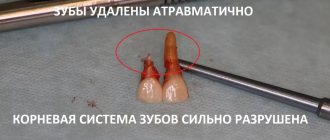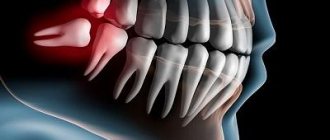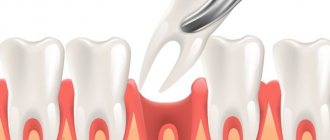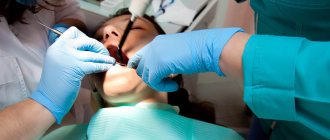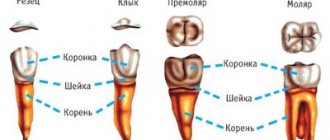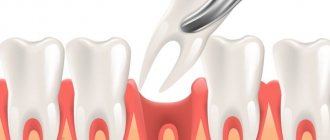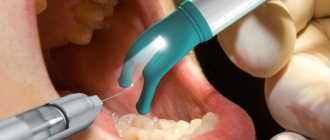At this stage of development of dental science, specialists are increasingly opting for atraumatic tooth extraction. This is the most painless and gentle procedure. After extraction, the bone walls of the socket are kept intact so that dental implantation is possible in the future without bone grafting or sinus lifting.
Tooth extraction is a complex surgical procedure that can result in damage to the bone socket, bleeding, and swelling. Thanks to the latest atraumatic removal technique, which is performed minimally invasively and with comfort for the patient, complications can be avoided. The walls of the tooth socket are preserved after removal, therefore, implantation is possible in the future.
At the innovative dental clinic "Implantmaster" in Moscow, atraumatic tooth extraction is performed by a maxillofacial surgeon. Our doctors improve themselves professionally and attend scientific conferences. Patients can always count on quality treatment. We are able to solve complex problems quickly, setting reasonable prices for services.
Next, you will learn how atraumatic removal is performed and its benefits. Let's get acquainted with the indications for this technique. Let's talk about the differences from regular removal.
Get a consultation
We will answer all your questions before visiting the clinic!
+7
Online registration
Content
1 The difference between atraumatic tooth extraction and conventional
2 Advantages of atraumatic tooth extraction
3 Indications for atraumatic tooth extraction
4 Stages of atraumatic tooth extraction 4.1 Comprehensive diagnostics
4.2 Preparation of membrane from plasma
4.3 Removal with a piezo scalpel and periotome
4.4 Application of blood plasma membrane
5 Disadvantages of piezosurgery for tooth extraction
6 Dental implantation immediately after extraction
7 Prices for atraumatic tooth extraction
The difference between atraumatic tooth extraction and conventional
Atraumatic tooth extraction involves extraction without forceps or burs. The ligaments are cut off from the dental unit, then segmentation is carried out using microsurgical blades. Subsequent extraction of fragments is easy. The procedure is performed safely, painlessly and comfortably.
The main advantage of gentle tooth extraction is that the healing of the bone hole proceeds much faster and the relief of the gum tissue is preserved. In the process of extracting fragments, the doctor does not affect the bone structures, maintaining the volume of the jaw bone around the hole. All necessary conditions are created for subsequent stable and complete implantation, and soon aesthetic prosthetics. This procedure makes it possible to immediately load the area with prosthetic structures immediately after tooth extraction.
Tooth extraction without pain in CELT
Dental surgeons at the CELT clinic perform tooth extractions absolutely painlessly thanks to modern anesthetics and extraction techniques. Painful sensations may occur after a complex operation to remove wisdom teeth during the recovery period, but for this purpose, we prescribe painkillers to patients and be sure to provide detailed instructions on all issues that arise.
For simple surgery, local anesthesia is used. It is also often used for complex operations, although there are cases when removal requires general anesthesia. This is possible if it is necessary to carry out a volumetric intervention, as well as when the patient has phobias and fears before the intervention. The selection of a drug for anesthesia is carried out individually after collecting an anamnesis, taking into account the patient’s chronic diseases and the presence of allergic reactions to certain drugs.
Tooth extraction in our modern clinic is a painless procedure, during which an implant can be installed. We take this seriously and know how to cope with any, even the most difficult situation, and have everything necessary for successful treatment.
Make an appointment through the application or by calling +7 +7 We work every day:
- Monday—Friday: 8.00—20.00
- Saturday: 8.00–18.00
- Sunday is a day off
The nearest metro and MCC stations to the clinic:
- Highway of Enthusiasts or Perovo
- Partisan
- Enthusiast Highway
Driving directions
Advantages of atraumatic tooth extraction
- The risk of infection of the bone socket is minimal due to the absence of trauma to the surrounding soft and hard tissues.
- Low likelihood of bleeding and various complications.
- Tissue regeneration occurs faster than with conventional removal.
- The bone plate between the roots and the physiological structure of the mucous membrane are preserved.
- There is no heating or soft tissue burns.
- The emphasis is on maintaining the original volume of the jawbone.
- The procedure is performed under local anesthesia with gentle drugs to minimize damage to nerve endings.
- Atraumatic tooth extraction with a piezosurgical scalpel produces coagulation of blood vessels, minimizing the risk of bleeding. It has an antiseptic and biostimulating effect.
Ultrasound removal of wisdom teeth
Removing a wisdom tooth using ultrasound is one of the most common manipulations in piezosurgery. There are several reasons for this. Firstly, the figure eights are initially located deep in the jaw, so it is sometimes very difficult to remove them using ordinary forceps. The situation is also complicated by various pathologies, which are very common in the case of wisdom teeth. First of all, this is retention and dystopia. In the most difficult cases, the wisdom tooth is not only hidden under a layer of bone and soft tissue and has an abnormal position. That is why removal of an impacted tooth using ultrasound is one of the most popular piezosurgical procedures. An ultrasonic device allows you to perform manipulations with pinpoint precision and work with bone in the most gentle manner. Removing wisdom teeth in the lower jaw using ultrasound can take a little longer and be more difficult (largely due to denser bone). Read more about wisdom tooth removal here.
Our team of doctors
Maxillofacial surgeon, Implantologist
Bocharov Maxim Viktorovich
Experience: 11 years
Dental surgeon, Implantologist
Chernov Dmitry Anatolievich
Experience: 29 years
Orthopedist, Neuromuscular dentist
Stepanov Andrey Vasilievich
Experience: 22 years
Endodontist, Therapist
Skalet Yana Alexandrovna
Experience: 22 years
Orthopedic dentist
Tsoi Sergey Konstantinovich
Experience: 19 years
Dentist-orthodontist
Enikeeva Anna Stanislavovna
Experience: 3 years
Indications for atraumatic tooth extraction
- Destruction of the tooth crown of more than 3/4, due to injury or carious process.
- It is not possible to carry out high-quality treatment or restoration of the tooth.
- Severe crowding, lack of space in the dentition, incorrect position.
- Complication of pulpitis or periodontitis.
- Purulent inflammation around the tooth root, cysts that cannot be treated without surgery.
- Creation of space for implant installation.
Rules for caring for the oral cavity after tooth extraction
To avoid adverse consequences, a number of rules must be followed after surgery:
- the first meal is possible after 2.5 - 3.5 hours;
- Do not touch the wound or the resulting clot;
- do not rinse your mouth;
- chew food on the opposite side;
- It is recommended that on the day of intervention, apply a cold compress to the sore side of the cheek for 15 minutes every 3 to 4 hours;
- You cannot drink alcohol, smoke, go to the sauna, or sunbathe.
Take medications prescribed by the surgeon. Visit the dentist for a checkup.
Stages of atraumatic tooth extraction
The essence of atraumatic extraction is the ultrasonic division of the tooth into the required number of fragments (depending on the number of roots) and their careful extraction. Thus, the integrity of the bone partitions between the roots and the socket walls is maintained, which plays an important role in regenerative processes. The further possibility of implantation and prosthetics depends on this.
Manipulations during atraumatic tooth extraction with ultrasound are similar to standard operations and are carried out by specialists from the Implantmaster clinic at a reasonable price. The only difference is the tools – an ultrasound machine and conventional elevators and forceps. The procedure consists of several stages:
1. Anesthesia.
All surgical interventions are performed under pain relief using local anesthesia. Our doctors perform atraumatic removal of all teeth, even multi-rooted ones.
2. Surgical intervention.
To prevent breakage of the bone septum between the roots, the maxillofacial surgeon and implant surgeon separates them from each other. Using a periotome, the marginal gum is gently moved away from the tooth to preserve its integrity. Next, using an innovative piezo scalpel - the VarioSurg LED ultrasonic surgical system from NSK (made in Japan) - the roots are separated and segmented. Removing fragments becomes safe, painless and as comfortable as possible for the patient.
3. Application of platelet membranes.
After all dental fragments are removed, platelet mass is injected into the socket. The mass contains cell growth factors that help accelerate tissue regeneration and healing. This prepares hard and soft tissues for further prosthetics on implants.
After atraumatic tooth extraction, the hole heals quickly and without complications such as swelling, bruising and bleeding. The most important thing is that the patient must strictly follow all the doctor’s recommendations.
Comprehensive diagnostics
Before performing atraumatic tooth extraction with ultrasound, it is necessary to consult a doctor and carry out a number of diagnostic measures.
1. Initial consultation.
To carry out an innovative dental technique of atraumatic tooth extraction with ultrasound at a reasonable price, the Implantmaster clinic in Moscow has all the necessary latest equipment. Before carrying out medical manipulations, a thorough visual and instrumental examination of the oral cavity is carried out at the consultation. Next, the specialist will order an x-ray.
We perform cone beam computed tomography. The pictures are more accurate, and the Rg radiation is even less. Thanks to this, the most accurate diagnosis can be made.
Our doctors use a Labomed Magna dental microscope to thoroughly examine the condition of teeth and surrounding tissues.
2. Analyzes.
An examination is carried out to determine contraindications to surgery. The specialist, using diagnostic data, identifies the possibilities of saving the tooth. And if this is not possible, then a plan for the operation is drawn up.
The doctor answers all the patient’s questions. He explains in detail the surgical procedure and schedules an appointment.
Immediately after ultrasound exposure, it can be implanted. Our highly qualified specialists use the latest materials and technologies, such as Straumann implants. Their osseointegration takes place in 3-5 weeks, and they can also be installed when the bone level is small.
What don't they tell you when your tooth is removed?
Any person experiencing toothache wants to get rid of a tooth quickly and doctors are delighted when they almost wave a magic wand and make the tooth fly out in a few seconds. But everything is not as simple as it seems at first glance.
Traumatic removal. This is, as a rule, a very quick removal, in which the doctor does not care about what will happen to the patient after, because... This is most likely an on-duty appointment at a free clinic, for which the doctor does not have too much time, and after this there is a queue of 10 of the same patients. What a patient with a missing tooth will do after such an appointment is the patient’s own problem.
After such removal, the bone is very often damaged, after healing, a bone tissue failure forms in the place of the missing tooth, and in the future this person will have to face very great difficulties with dentures. He will not be able to install a normal implant, he will not be able to select a suitable prosthesis so that it is beautiful, aesthetic and functional.
Another problem with such rapid removal is poorly cleaned inflammation inside the socket (cyst, granuloma). Such a hole takes a very long time to heal and bothers its owner. And even years later, the hole never fully heals. Therefore, quick deletions do not create good consequences in most cases.
During atraumatic removal, the doctor always thinks not only about how to remove the tooth, but also how to remove the tooth so that in the future, when the bone heals, it does not lose volume. This is the main task. Because after some time, maybe in a year or five years, a person will want to get an implant or other types of prosthetics, and for this it is necessary that the place where the tooth was once located has a certain shape. And a doctor who removes a tooth in an atraumatic way always pursues the following tasks:
- calculate how to remove a tooth so as not to break the bone socket; — how to reduce soft tissue damage to a minimum; — how to create such conditions after removal so that the hole heals as quickly as possible and does not sag in the bone.
This procedure is more complicated and more expensive than traumatic removal, but let’s try to do the math together. Atraumatic removal in our clinic starts from 6,000 rubles versus 1,000 in some other clinic. You overpay 5,000 rubles now, but save 30,000 rubles in the future on bone augmentation operations when you want to have prosthetics with implants. You don’t have to waste your time and nerves, and that’s the most important thing, don’t you think?
Book a consultation with our surgeon right now and you will save money!
Get a consultation
We will answer all your questions before visiting the clinic!
+7
Online registration
Preparation of plasma membrane
The membrane is made in the morning or 4 hours after eating (water can be drunk, even necessary). The procedure takes about half an hour.
- In the treatment room, blood is taken from a vein in the patient's elbow.
- The biomaterial is placed in a specialized apparatus, where it is centrifuged to separate the plasma.
- In laboratory conditions, doctors obtain the necessary plasma and saturate it with anticoagulants.
The procedure is quite quick and painless. To minimize risks, you should carefully approach the search for a good clinic and an experienced doctor. Implantmaster employs highly qualified specialists who regularly improve their skills and knowledge.
Removal using a piezo scalpel with a periotome
At the Implantmaster clinic, all surgical interventions are performed using anesthesia. Our specialists perform atraumatic removal of any teeth using ultrasound.
The dentist-surgeon, first of all, uses a periotome to separate the adjacent gum from the tooth on all sides. To preserve the bone septum between the roots, the doctor separates the roots from each other. An innovative piezo scalpel - the VarioSurg LED ultrasonic surgical system - separates the roots from the coronal part and their subsequent segmentation. Removal is as safe and painless as possible. Even the most difficult operations are carried out without further complications.
Application of blood plasma membrane
The use of platelet membranes containing cell growth factors accelerates tissue regeneration and healing. During surgery, the membrane covers the defect, implanted bone material or artificial root. Sometimes a fibrin clot is combined with the patient's bone material and introduced into the defect area. Afterwards, suture material is applied. If the membrane was installed to prevent inflammation, then sutures are not applied. It is not advisable to rinse your mouth during the first 3 days.
The introduction of a platelet membrane naturally activates cellular growth factors of the jaw bone and periodontal tissues, increasing the rate of recovery. Regeneration and acceptance of implants or bone material by the body is much faster, and the likelihood of inflammation is significantly minimized.
Blood plasma membranes have a positive effect on:
- increase in the rate of cellular growth factor in the bone after implantation;
- absence of allergies that could occur when interacting with foreign materials;
- accelerated gum recovery after implantation or plastic surgery;
- prevention of inflammation around the implant;
- reduction of swelling and pain after surgical procedures;
- optimal tightening of the socket after tooth extraction;
- minimizing inflammation during gingival curettage and cleaning periodontal pockets.
What does a dental surgeon do?
The range of services of the center for maxillofacial surgery and dentistry in Moscow Dentpremium includes procedures that can be performed in the clinic. You can get information on the official website of the center. If you would like to receive advice on individual indications for visiting a dental surgeon, our specialists will be ready to answer, and all questions by phone.
Removal of a tooth
Simple tooth extraction procedures can be performed by a general dentist. However, if there is inflammation, formations or other abnormalities that cause indications for complex tooth extraction, the operation is performed by a surgeon.
Indications for complex removal:
- impacted teeth are teeth that did not erupt in time due to improper placement and began to grow inside the gums;
- diseased or pathological wisdom tooth;
- teeth that have erupted outside the dentition or are in an incorrect position;
- painters with 2-3 roots (if necessary removal);
- tooth root pathology;
- fusion of the jaw bone with the tooth root;
- fistulas, cysts, etc.;
- increased fragility of dental bone tissue.
In such cases, cutting of soft tissue and the use of surgical instruments will most likely be required. The work of a dental surgeon can take from 20 minutes to 3 hours.
Tooth preservation
Dental surgery does not always involve tooth extraction. The doctor’s actions can be aimed, on the contrary, at preserving the tooth.
In such cases, the presence of neoplasms (for example, a cyst) or inflammatory processes may serve as an indication. The operation is carried out with the mandatory use of anesthesia. As a result of surgical intervention, the vital activity of the tooth and, accordingly, its functionality are preserved.
The operation involves increased complexity of the specialist’s work. At the Dentpremium clinic, operations are performed by the best dental surgeon in Moscow, who has extensive experience and high qualifications.
Implantation
To restore an extracted tooth, a procedure such as implantation is necessary.
At the Dentpremium center, the service is provided by the joint work of an orthodontist and a surgeon. The result of implantation depends on the qualifications and experience of doctors. The procedure involves implanting an artificial tooth root into the soft tissue, on which a crown will subsequently be installed to replace a real tooth. The choice of implant and fastening of the crown is carried out by an implantologist or orthodontist, but implantation is a more complex procedure that requires special skills and knowledge.
The dentist-surgeon determines the specifics of installing the pin and, when indicated, participates in the procedure for increasing jaw tissue and correcting deviations of the alveolar ridge. It is also often necessary to consult a dental surgeon when modeling implants in computer programs.
Gumplasty
You cannot do without the help of a good dental surgeon if gum surgery is necessary.
Indications for plastic surgery to correct gums may include:
- complications after implantation;
- the need for correction of gum tissue after a two-stage method of installing implants with delayed loading;
- the presence of complications, or in combination with other types of treatment, for periodontal disease or periodontitis;
- anomalies of the dental system or bite.
The goal of the maxillofacial dental surgeon is to restore the aesthetic appearance of the gum contour. For correction, resection of the mucosa can be used, followed by the application of its tissue to pathological areas.
Anomalies of the dental system
There are many conservative methods for correcting the dental system for congenital and acquired pathologies. However, not all diseases and anomalies can be eliminated by therapeutic methods. If there are complex pathologies for which the help of an orthodontist is ineffective, dental maxillofacial surgery is the treatment.
The goal of a maxillofacial surgeon is to correct jaw proportions and eliminate deviations. Any treatment for diseases of this type requires the help of an orthodontist and long-term rehabilitation. As a rule, after surgery the patient still has to wear orthodontic appliances.
Abnormalities of the jaw and teeth cause not only an aesthetic defect (ugly smile), but also many health problems (disruption of the gastrointestinal tract, increased cerebral pressure, inflammation of the jaw joints, dental diseases, etc.), and also cause speech defects.
Plastic surgery of oral tissues
Due to injury or a disorder in intrauterine development, a person may experience impaired oral opening (i.e., the mouth does not open completely). The cause of the pathology is the tension of the muscle tissue located between the mouth and teeth.
To correct the defect, the services of a dental surgeon are necessary. The specialist performs an operation - vestibuloplasty. As a result of surgical intervention, not only the aesthetic defect is eliminated, but also correct speech and articulation are restored and the risks of developing dental diseases are reduced.
The Dentpremium clinic performs frenuloplasty. This procedure is familiar to many - correction of the frenulum of the lips or tongue.
Disadvantages of piezosurgery for tooth extraction
1. The cost of atraumatic tooth extraction can be considered a disadvantage. It is slightly higher than with classical extraction. The cost is made up of professional training, training of a dental surgeon and the use of innovative, expensive equipment. In practice, the safety and reliability of the procedure compensate for the price component.
2. Limited prevalence of the technique. Not all clinics have the necessary equipment and staff training, especially clinics.
Removal of a tooth cyst
A dental cyst is a purulent formation covered with a dense membrane. It appears as a consequence of inflammatory processes, including as a result of inadequate or untimely treatment of periodontitis. In most cases, the cyst is discovered in the later stages, when therapy no longer helps and only removal remains. However, proper and high-quality surgical intervention can help preserve a living tooth.
The surgical department of our clinic performs tooth extraction of any complexity. But not in all cases such drastic decisions are needed. The main goal of surgical dentistry is not just to remove a diseased tooth, but to do everything possible to preserve it. Modern technologies and surgical methods make it possible to successfully perform tooth-preserving operations and resort to radical measures only in cases where other methods are inapplicable.
Dental implantation immediately after extraction
The single-stage implantation operation involves installing an artificial root directly into the socket of the extracted tooth. All manipulations can be performed in one visit. This procedure is most in demand when prosthetics are needed in the smile area. The primary goal is to achieve high aesthetics of restorations.
With the help of one-stage implantation, it is possible to significantly reduce the rehabilitation period. It is also possible to fix a temporary prosthesis, allowing the patient to immediately begin the process of chewing food.
Our highly qualified specialists use Straumann and Osstem implants. Healing of Straumann implants occurs within a month, and even a small level of bone will not interfere with installation.
Removal methods
Depending on the location of the affected unit and the complexity of the clinical case (last units in a row, significant destruction of the crown, retention, dystopia), removal can be carried out according to two different protocols: simple and complex. The first operation lasts about a quarter of an hour, complex extraction - approximately half an hour. Operation scheme:
- Anesthesia (local, general).
- Treating the oral cavity with an antiseptic.
- Separation of the circular ligament from the neck of the tooth with a scalpel or smoother.
- Simple method. Forceps are applied to the diseased segment and dislocated. The unit is removed from the alveoli.
- For difficult removal. The gum is cut with a scalpel. The crown is split into pieces (with a chisel or drill), which are then pulled out of the hole one by one. The root is separated from the gum with a periotome and removed with an extractor (or forceps). The wound is sutured.
- Inspection of the hole using a curettage spoon.
- Medical tamponade of the wound opening.
Wisdom tooth removal
A wisdom tooth can be removed only according to the following indications:
- cystic formation in the apical zone;
- dystopia;
- carious destruction;
- the appearance of a gingival hood;
- impaired eruption (pericoronitis);
- cause problems with bite;
- previous orthodontic treatment.
Removal of front teeth
Extraction of segments of the smile zone is carried out for medical and aesthetic reasons:
- purulent periodontitis;
- crown fracture exposing the pulp;
- severe destruction of the supragingival part of the segment without the possibility of its use as a support for the crown;
- complete, partial retention;
- extreme degree of mobility in severe periodontitis;
- jaw injury (if the segment is located in the fracture gap);
- a supernumerary element that disrupts diction and interferes with chewing food.
Removal of impacted and dystopic teeth
The retention of a segment in the jaw or alveolar process is called retention. Dystopia is an abnormal eruption of a unit. Both pathologies disrupt the bite and negatively affect speech, chewing, and swallowing.
Impacted and dystopic segments can damage neighboring teeth and disrupt the functioning of the temporomandibular joint. They often cause inflammation, accompanied by pain and swelling of the gums. Before removing such units, an x-ray examination is performed. Based on its results, the issue of the need for extraction is decided.
Prices for atraumatic tooth extraction
Tooth extraction is simple:
- X-ray images
- Anesthesia
- Removal of a tooth
- Applying and removing sutures
- Postoperative examinations
Price : from 3,000 ₽ to 7,800 ₽
Tooth extraction is complicated
| from 10,000 to 20,00 ₽ |
Author:
Questions and answers
Is there an appointment with the surgeon? To make an appointment with a surgeon, contact the reception desk in person or call. In addition, if you live in Moscow, you can leave a request on the website in the “Teeth Removal” section
Where to remove a tooth? How to find your clinic? North-Eastern Dental Center No. 1 is located near the Otradnoye metro station, at the address: Moscow, st. Pestelya, no. 6.
Is it possible to have a tooth pulled out during pregnancy? Removal is a surgical operation performed using anesthesia. In addition, manipulation is a stress factor for the body. Therefore, extraction of the diseased segment during this period is only indicated.
I have caries in my back seven. How much does it cost to extract a tooth under general anesthesia? The cost depends on the complexity of the operation. The preliminary amount to be paid will be announced by the doctor at the initial consultation.
Does it hurt to have teeth removed? Modern methods and medications allow atraumatic tooth extraction without pain!


